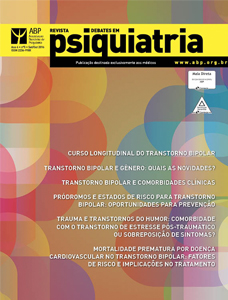Trauma e transtornos do humor: comorbidade com o transtorno de estresse pós-traumático ou sobreposição de sintomas?
DOI:
https://doi.org/10.25118/2236-918X-6-5-5Palavras-chave:
Trauma, transtornos do humor, transtorno de estresse pós-traumático, sintomas disfóricos, Research Domain CriteriaResumo
O presente artigo discorre sobre a comorbidade entre transtorno bipolar (TB) e transtorno de estresse póstraumático (TEPT) e questiona sobre certos casos serem melhor avaliados à luz das novas teorias do Research Domain Criteria (RDoC), principalmente aqueles quadros de TEPT com sintomas disfóricos que podem ser classificados como TB, apesar de não preencherem critérios para tal. Nesse caso, questiona-se a comorbidade e propõe-se um aprofundamento da fisiopatologia dessa sintomatologia que está sobreposta. Clinicamente, esse olhar poderá facilitar o manejo farmacológico de pacientes graves com histórico de trauma.
Downloads
Métricas
Referências
Hernandez JM, Cordova MJ, Ruzek J, Reiser R, Gwizdowski IS, Suppes T, et al. Presentati on and prevalence of PTSD in a bipolar disorder populati on: a STEP-BD examinati on. J Aff ect Disord. 2013;150:450-5.
Quaranti ni LC, Miranda-Scippa A, Nery-Fernandes F, Andrade-Nascimento M, Galvão-de-Almeida A, Guimarães JL, et al. The impact of comorbid postt raumati c stress disorder on bipolar disorder pati ents. J Aff ect Disord. 2010;123:71-6.
American Psychiatric Associati on. Diagnosti c and Stati sti cal Manual of Mental Disorders, Fift hEditi on (DSM-5). Arlington: American Psychiatric Publishing; 2013.
Armour C, Mullerova J, Elhai JD. A systemati c literature review of PTSD’s latent structure in the Diagnosti c and Stati sti cal Manual of Mental Disorders: DSM-IV to DSM-5. Clin Psychol Rev. 2016;44:60-74.
Associação Americana de Psiquiatria. Manual Diagnósti co e Estatí sti co de Transtornos Mentais, 4ª edição (DSM-IV). Porto Alegre: Artes Médicas; 1995.
Elhai JD, Palmieri PA. The factor structure of postt raumati c stress disorder: a literature update, criti que of methodology, and agenda for future research. J Anxiety Disord. 2011;25:849-54.
Hansen M, Armour C, Elklit A. Assessing a dysphoric arousal model of acute stress disorder symptoms in a clinical sample of rape and bank robbery victi ms. Eur J Psychotraumatol. 2012;3. doi: 10.3402/ejpt.v3i0.18201. Epub 2012 Jun 12.
Nardi AE, Kapczinski F, Quevedo J, Hallak JE, Freire R, Romano-Silva MA. The quest for bett er diagnosis: DSM-5 or RDoC? Rev Bras Psiquiatr. 2013;35:109-10.
Nati onal Insti tute of Mental Health (NIMH). Research Domain Criteria (RDoC) [Internet]. 2016 [cited 2016 Oct 18]. https://www.nimh.nih.gov/research-priorities/rdoc/index.shtml
Iwata M, Ota KT, Duman RS. The infl ammasome: pathways linking psychological stress, depression, and systemic illnesses. Brain Behav Immun. 2013;31:105-14.
Passos IC, Vasconcelos-Moreno MP, Costa LG, Kunz M, Brietzke E, Quevedo J, et al. Infl ammatory markers in post-traumati c stress disorder: a systemati c review, meta-analysis, and metaregression. Lancet Psychiatry. 2015;2:1002-12.
Berk M, Williams LJ, Jacka FN, O’Neil A, Pasco JA, Moylan S, et al. So depression is an infl ammatory disease, but where does the infl ammati on come from? BMC Med. 2013;11:200.
Buchmann AF, Holz N, Boecker R, Blomeyer D, Rietschel M, Witt SH, et al. Moderati ng role of FKBP5 genotype in the impact of childhood adversity on corti sol stress response during adulthood. Eur Neuropsychopharmacol, 2014;24:837-45.
Soeiro-de-Souza MG, Dias VV, Figueira ML, Forlenza OV, Gatt az WF, Zarate CA Jr, et al. Translati ng neurotrophic and cellular plasti city: from pathophysiology to improved therapeuti cs for bipolar disorder. Acta Psychiatr Scand. 2012;126:332-41.
Rakofsky JJ, Ressler KJ, Dunlop BW. BDNF functi on as a potenti al mediator of bipolar disorder and post-traumati c stress disorder comorbidity. Mol Psychiatry. 2012;17:22-35.
Milad MR, Rosenbaum BL, Simon NM. Neuroscience of fear exti ncti on: implicati ons for assessment and treatment of fear-based and anxiety related disorders. Behav Res Ther. 2014;62:17-23.
Mello MF, Faria AA, Mello AF, Carpenter LL, Tyrka AR, Price LH. [Childhood maltreatment and adult psychopathology: pathways to hypothalamicpituitary-adrenal axis dysfuncti on]. Rev Bras Psiquiatr. 2009;31:S41-8.
Nusslock R, Miller GE. Early-life adversity and physical and emoti onal health across the lifespan: a neuroimmune network hypothesis. Biol Psychiatry. 2016;80:23-32.
Downloads
Publicado
Como Citar
Edição
Seção
Licença

Este trabalho está licenciado sob uma licença Creative Commons Attribution-NonCommercial 4.0 International License.
Debates em Psiquiatria permite que o (s) autor (es) mantenha(m) seus direitos autorais sem restrições. Atribuição-NãoComercial 4.0 Internacional (CC BY-NC 4.0) - Debates em Psiquiatria é regida pela licença CC-BY-NC
































